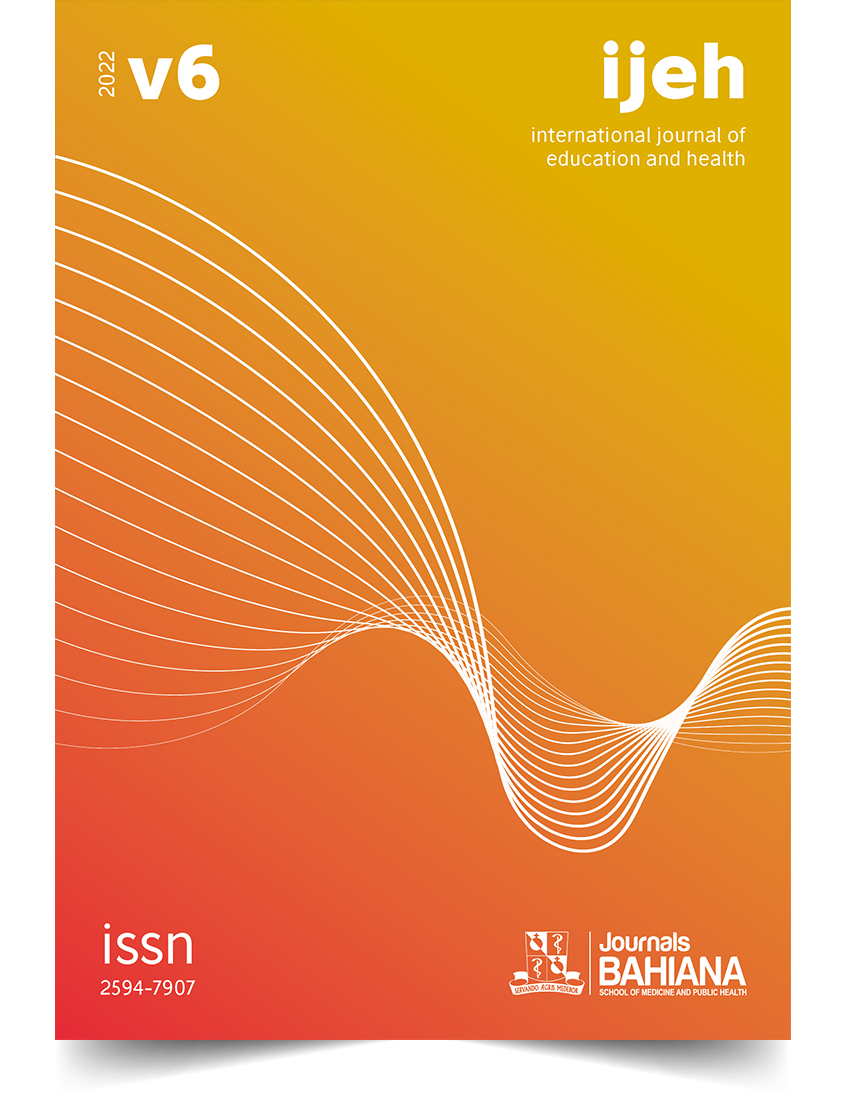Virtual Seminar: an innovative educational experience
DOI:
https://doi.org/10.17267/2594-7907ijeh.2022.e3964Keywords:
Education, Medical, Teaching, LearningAbstract
INTRODUCTION: it is of special importance that teachers can easily transmit knowledge, using didactical tools such as Cmaptools, Slideshare, YouTube, among others. Because of that, teaching methods nowadays are going through a revolution that implies technological development and the arrival of new generations. OBJECTIVE: describe the experience of developing a virtual education strategy in our institution to improve the teaching and learning process and facilitate interaction with students. METHODOLOGY: the students must do a bibliography search in databases (PubMed, Science Direct, and Embase) choosing one recent (published within the previous 3 months) original article in English. The article must involve the use of molecular techniques that include some sort of electrophoresis, then, get a tutoring session with the main teacher of the course, after that, the student must design a PowerPoint slideshow of a maximum of 15 slides. Finally, must record a 10-minute-long video of the presentation, the video must be uploaded to the YouTube website. RESULTS: a greater comprehension of the seminar presentation dynamic was observed in comparison to the previous methodology, which did not include the virtual component. CONCLUSIONS: the implementation of new innovative methodologies in education allows students to develop a broader learning process, besides improving their scientific understanding; they improve their knowledge on technological tools implemented in education.
Downloads
References
Castrillón JJC. La reforma curricular del Programa de medicina de la universidad de Manizales. Arch Med (Manizales) [Internet]. 2012;12(2):137-9. Available from: https://www.redalyc.org/pdf/2738/273825390008.pdf
Múnera EMV, Rave ÁMA, Muñoz CA. La renovación curricular en el programa de Medicina de la Universidad de Antioquia. Iatreia [Internet]. 2007;20(4):422-44. Available from: https://revistas.udea.edu.co/index.php/iatreia/article/view/4425
Forero DA, Majeed MH, Ruiz-Díaz P. Current trends and future perspectives for medical education in Colombia. Med Teach. 2020;42(1):17-23. https://doi.org/10.1080/0142159x.2019.1659944
Franco RLO, Machado JLM, Grinbaum RS, Porfírio GJM. Barriers to outpatient education for medical students: a narrative review. Int J Med Educ. 2019;10:180-90. https://dx.doi.org/10.5116%2Fijme.5d76.32c5
Mure?an S, Meda-Georgescu A, Azamfirei L, Oana-Marginean C, Cm-Taylor D. Medical education in Romania: Tradition and innovation. Med Teach. 2019;41(6):619-24. https://doi.org/10.1080/0142159X.2018.1552932
Rohlfsen CJ, Sayles H, Moore GF, Mikuls TR, O'Dell JR, McBrien S, et al. Innovation in early medical education, no bells or whistles required. BMC Med Educ. 2020;20(1):39. https://doi.org/10.1186/s12909-020-1947-6
Kurata S, Fujiki T, Murota M. Developing an online video presentation evaluation system to promote mutual evaluation and survey of operability [Internet]. Proceedings of the 24th International Conference on Computers in Education; 2016; India. Available from: http://www.et.iitb.ac.in/icce2016/files/proceedings/ICCE%202016%20Main%20Conference%20Proceedings.pdf
Ferreira PB, Cohrs CR, De Domenico EB. Software CMAP TOOLS ™ to build concept maps: an evaluation by nursing students. Rev Esc Enferm USP. 2012;46(4):967-72. https://doi.org/10.1590/s0080-62342012000400026
Tackett S, Wright SM, Quirk M. Adaptive medical education research. Med Teach. 2018;40(8):783-5. https://doi.org/10.1080/0142159x.2018.1490705
Rodríguez-Ríos A, Espinoza-Téllez G, Martínez-Ezquerro JD, Rendón-Macías ME. Information and Communication Technology, Mobile Devices, and Medical Education. J Med Syst. 2020;44(4):90. https://doi.org/10.1007/s10916-020-01559-w
Lifshitz-Guinzberg A, Abreu-Hernández LF, Sepúlveda-Vildósola AC, Urrutia-Aguilar ME, Córdova-Villalobos JÁ, López-Bárcena J, et al. Pros and cons of innovations in medical education. Gac Med Mex. 2021;157(3):325-34. https://doi.org/10.24875/gmm.m21000568
Pontes-Pedrajas A. Representación y comunicación del conocimiento con mapas conceptuales en la formación del profesorado de ciencia y tecnología. Revista Eureka sobre Enseñanza y Divulgación de las Ciencias [Internet]. 2012;9(1):106-23. Available from: https://helvia.uco.es/bitstream/handle/10396/8134/7_Pontes_2012.pdf?sequence=1
Fatima A, Zaman S, Asim HM. Educational outcome in scenario and powerpoint presentation based learning strategies among undergraduate physical therapy students. Rawal Med J [Internet]. 2018;43(1):146-50. Available from: https://www.rmj.org.pk/fulltext/27-1501583247.pdf
Ginkel S, Gulikers J, Biemans H, Mulder M. Towards a set of design principles for developing oral presentation competence: A synthesis of research in higher education. Educ. Res. Rev. 2015;14:62-80. https://doi.org/10.1016/j.edurev.2015.02.002
Crow J, Murray JA. Online Distance Learning in Biomedical Sciences: Community, Belonging and Presence. Adv Exp Med Biol. 2020;1235:165-78. https://doi.org/10.1007/978-3-030-37639-0_10
Kecskes Z, Mitchell I. Introducing a new series on innovations in medical education. Med J Aust. 2017;206(1):13. https://doi.org/10.5694/mja16.01212
Nadama HH, Tennyson M, Khajuria A. Evaluating the usefulness and utility of a webinar as a platform to educate students on a UK clinical academic programme. J R Coll Physicians Edinb [Internet]. 2019;49(4):317-322. Available from: https://www.mja.com.au/journal/2017/206/1/introducing-new-series-innovations-medical-education
Kay D, Pasarica M. Using technology to increase student (and faculty satisfaction with) engagement in medical education. Adv Physiol Educ. 2019;43(3):408-13. https://doi.org/10.1152/advan.00033.2019
Adams K. Modelling success: Enhancing international postgraduate research students’ self-efficacy for research seminar presentations. High. Educ. Res. Dev. 2004;23(2):115–30. https://doi.org/10.1080/0729436042000206618
Torralba KD, Doo L. Active Learning Strategies to Improve Progression from Knowledge to Action. Rheum Dis Clin North Am. 2020;46(1):1-19. https://doi.org/10.1016/j.rdc.2019.09.001
Quintanilha LF, Costa GN, Coutinho MR. Medical student perceptions about active methodologies in the study of physiology in medical schools in Salvador, Brazil. Adv Physiol Educ. 2018;42(4):693-6. https://doi.org/10.1152/advan.00105.2018
Bucklin BA, Asdigian NL, Hawkins JL, Klein U. Making it stick: use of active learning strategies in continuing medical education. BMC Med Educ. 2021;21(1):44. https://doi.org/10.1186/s12909-020-02447-0
Almarzooq ZI, Lopes M, Kochar A. Virtual Learning During the COVID-19 Pandemic: A Disruptive Technology in Graduate Medical Education. J Am Coll Cardiol. 2020;75(20):2635-8. https://pubmed.ncbi.nlm.nih.gov/32304797/
De Gerz L, Valcke M, Roozen I. The impact of an innovative instructional intervention on the acquisition of oral presentation skills in higher education. Comput Educ. 2009;(53):112–20. https://doi.org/10.1016/j.compedu.2009.01.005
Downloads
Published
Issue
Section
License
Copyright (c) 2022 Lina Maria Martinez-Sanchez, Yuban Sebastian Cuartas-Agudelo, Alejandro Hernandez-Martinez, Laura Herrera-Almanza, Miguel Saavedra-Valencia

This work is licensed under a Creative Commons Attribution 4.0 International License.
This work is licensed under a Creative Commons Attribution 4.0 International License.



